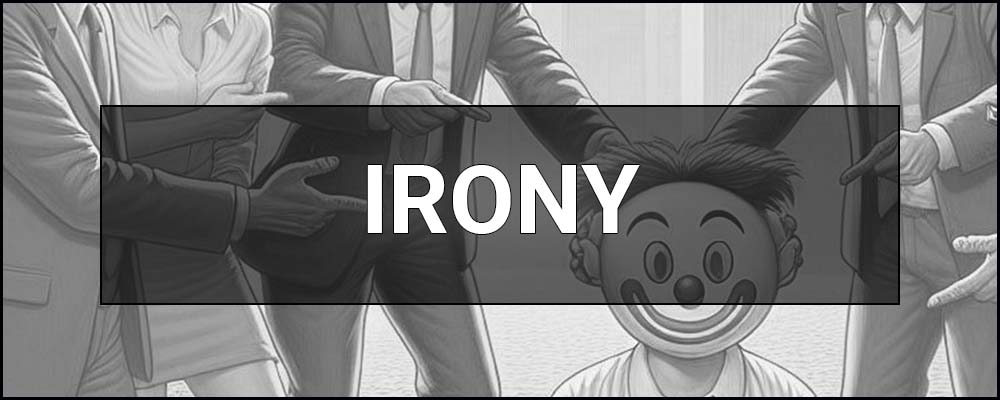Irony is a rhetorical device or expression where the true meaning is the opposite of the literal meaning, often used for humor or criticism.
What is IRONY — concept and definition in simple words.
In simple words, Irony is when you say or show one thing but actually mean something completely different, often the opposite.
It could be, for example, when you say “Great weather!” with a smile in the middle of a downpour, or when a movie shows a character thinking everything is going according to plan, but we, the audience, see it going wrong. Irony is a play on words and situations used to provide humor, criticism, or a deeper understanding of something.
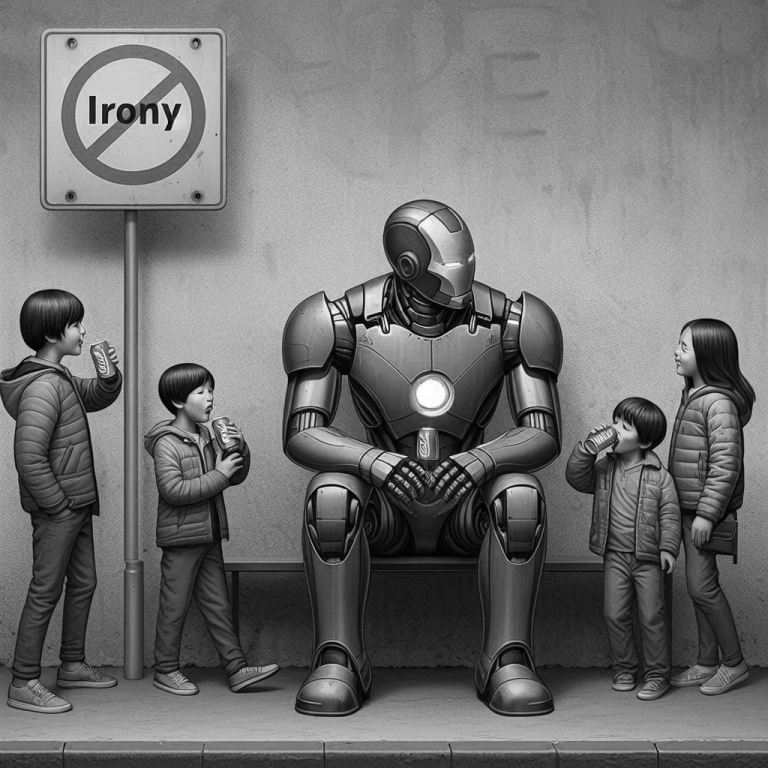
Types or kinds of irony: brief definition and examples.
Irony exists in many forms and has different manifestations, each with its own unique characteristics and contexts.
- Classical Irony: This is a form of irony where the true meaning of statements or situations is the opposite of what is literally said or portrayed. For example, when someone says “It’s straight up hot as hell today” while there is a bitter cold and blizzard outside.
- Cosmic Irony: This is the use of irony to highlight the idea that the universe or fate has plans of its own that are contrary to human expectations or aspirations.
- Verbal Irony: Here, irony arises from the differences between the literal and hidden meaning of what is expressed. This is when words are used to express something opposite to their ordinary meaning.
- Situational Irony: This type of irony occurs when the actual outcome of a situation is directly opposite to what was expected or predicted.
- Dramatic Irony: This occurs in theater or literature when the audience knows more about a situation than the characters, creating tension or special insight.
- Tragic Irony: A type of dramatic irony where a character acts on false perceptions, leading to tragic consequences.
- Post-irony: A modern type of irony where irony is used so often and in such contexts that it becomes difficult to determine if there is any seriousness in the statement at all.
- Meta-irony: This is a complex form of irony where the act of irony itself becomes the object of ironic perception, creating a double layer of irony.
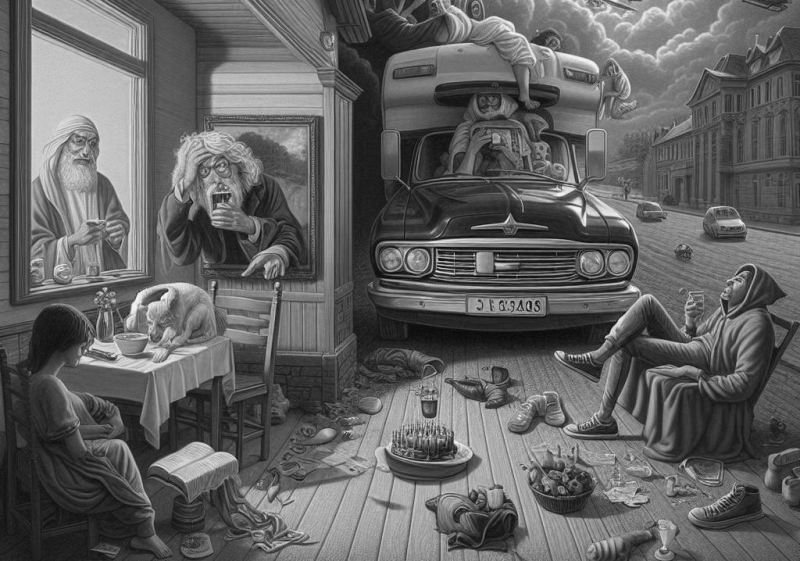
The essence of irony from the point of view of sociology.
Irony is not only a humorous device, but also a means of social interaction that plays a key role in the formation of interpersonal relations. In a society where irony serves as a linguistic and cultural phenomenon, it is often used as a tool of criticism or self-expression.
- Political irony: In the context of political debates, irony can be used to emphasize the discrepancy between politicians’ statements and their actions. For example, when a politician talks about the importance of health care but votes against reforms in this area.
- Social media: In social media, irony is often used to create a humorous effect or to ridicule social norms and stereotypes. For example, sarcastic memes that mock behavioral clichés.
- Advertising and marketing: In advertising campaigns, irony can be used to attract the attention of consumers by ridiculing certain products or services. For example, advertisements that portray people who are overly fond of trinkets, hinting at the unnecessary exaggeration in advertising.
- Cinematography: In films, irony can be used to create an unexpected plot twist or to emphasize differences in characters. For example, when a plucky hero suddenly turns out to be an amusing coward at a critical moment.
These examples reflect the multiplicity and depth of irony in social interactions, its way of expressing complex ideas in a simple yet profound way. Irony is a tool that allows us to better understand society and our role in it. It is important to realize that irony is not just words, but an entire concept that plays an important role in cultural and social contexts.
What is literary irony?
Literary irony is an elegant and multifaceted technique used to give deeper meaning to texts, it is a kind of bridge between the direct meaning of the word and its hidden essence.
Irony in literature becomes a kind of lens through which the reader can see not only the true meaning of the work, but also reveal the deeper author’s intentions.
Classic examples of literary irony are:
- Jonathan Swift’s A Modest Proposal: Irony is the sarcastic suggestion of solving poverty by eating the children of the poor. It is a satire against the cruelty of British policy in Ireland.
- “Pride and Prejudice” Jane Austen: The irony in the work is evident in the description of the characters’ attitudes toward marriage and love, often through poignant dialog and internal monologues that mock the stereotypes of the time.
- Geoffrey Chaucer’s The Canterbury Tales: Irony is evident in the use of humor and satire to criticize various aspects of society in medieval England, from ecclesiastical corruption to societal norms.
- Don Quixote by Miguel de Cervantes: The irony in the work lies in the contrast between reality and the perceptions of the main character who opposes windmills, believing them to be giants.
- Jonathan Swift’s Gulliver’s Travels: The irony lies in the use of fantastic travels to mock the real social and political orders of the time.
- Dead Souls by Nikolai Gogol: The irony in the work is the exposure of societal ills through the story of the purchase of “dead souls” for personal enrichment.
Contemporary examples of literary irony:
- Jerome Salinger’s The Catcher in the Rye: The irony lies in the perception of the world by the main character, Holden, who criticizes the superficiality and falsity of society while also being a part of it.
- George Orwell’s 1984: The deep irony in the dystopian work is in the exposure of the totalitarian regime, where the slogan “War is Peace” acts as a criticism of dictatorship and propaganda.
- Kurt Vonnegut’s Cat’s Cradle: Uses irony to mock scientific research and religious beliefs, showing the absurdity of modern society.
- American Psycho by Bret Easton Ellis: The irony of the work lies in the portrayal of the main character, who is a murderer, but is also portrayed as a typical member of upper class society.
- White Teeth by Zadie Smith: The irony of the book is the reflection of multicultural London and the complexity of family and intercultural relationships in today’s world.
Literary irony not only entertains the reader but also makes them think about deeper themes such as morality, societal norms, and individuality. It allows authors to express their views subtly, without resorting to direct condemnation, but rather giving the reader the opportunity to discover the truth.
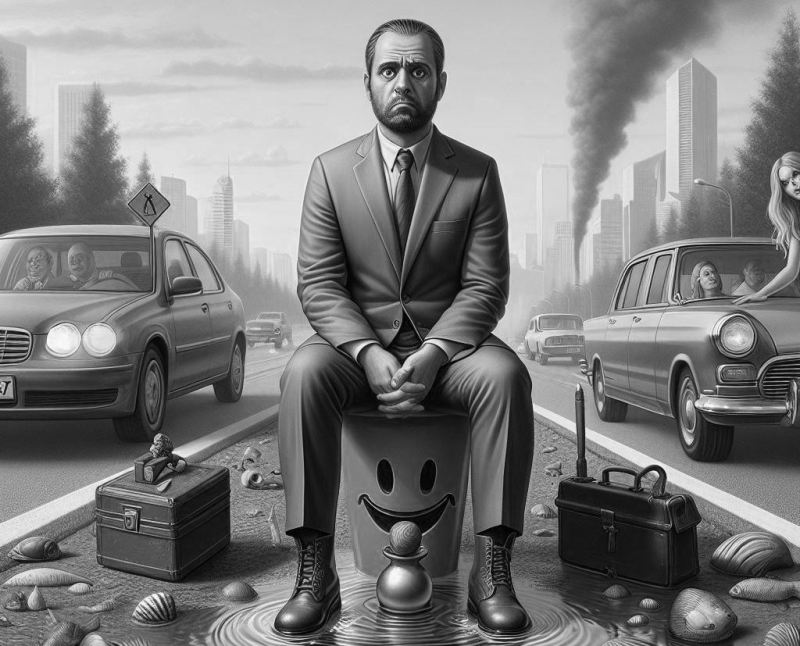
Irony in everyday communication.
Irony in everyday communication plays a significant role, being not just a stylistic device, but a way of expressing emotions, criticism, or even creating a humorous effect. It manifests itself in two main forms: verbal irony and situational irony.
- Verbal irony.
Verbal irony occurs when the literal meaning of an utterance contradicts its true intent. For example, when someone says “Runs clear as a Swiss watch” in response to an obvious computer glitch. This way of speaking can be used to gently criticize or show dissatisfaction while maintaining a positive tone of conversation. - Situational irony.
Situational irony involves an unexpected discrepancy between expectations and reality. For example, when the host of a TV show about healthy lifestyle is caught smoking. This type of irony is often seen in everyday situations and can elicit laughter or even sarcasm.
Misunderstandings and humor.
However, irony can cause more than just positive emotions. Because of its multiple meanings, it is sometimes difficult to interpret ironic statements correctly, which can lead to misunderstandings. This is especially true in cross-cultural communication, where different cultural contexts can distort the original intention of irony. Despite this, in many cases irony serves as a source of humor, allowing serious topics or even taboo issues to be discussed in an easy and relaxed manner.
Irony in everyday speech is not only a way of speaking, but also a means of developing critical thinking and social awareness. It allows people to express their thoughts and feelings in an unconventional yet effective way.
Irony in the digital age.
In the digital age, irony has taken on new forms and manifestations, especially in the realm of online communication. Social media and memes have become powerful tools for conveying ironic messages, but also a source of misunderstandings.
Online communication.
During online communication, it is not only the words that become important, but also the context in which they are used. Due to the lack of non-verbal cues such as intonation or facial expressions, ironic statements can be taken literally, leading to misunderstandings. To avoid this, users often resort to using emoji or special symbols that emphasize the ironic intent.
Examples of ironic online statements and their analysis.
- “I’m looking forward to Monday!”: This expression is often used in contexts where people usually complain about the beginning of the work week. It is ironic to use a phrase that is usually associated with positive expectations in a situation that usually evokes the opposite feelings.
- “It’s a success!” (usually with an emoji crying with laughter — LOL): This ironic expression is used when someone wants to express their disappointment or failure. The laughing emoji is added to emphasize the sarcastic undertone.
- “Great, everything is going according to plan”: Used in situations where things are going completely off track. The irony lies in the contrast between the text and the actual situation.
- “Yes, of course, I totally believe it”: This expression is often used when someone wants to express doubt or disbelief about something. It is ironic to use a phrase that normally means trust to express skepticism.
These expressions illustrate how irony in online communication is used to express skepticism, frustration, or even self-irony, and often requires readers to have a deeper understanding of the context and emotional subtext.
Memes as an expression of irony.
Memes have become a true artifact of contemporary culture, often using irony to comment on social, political, and cultural phenomena. They combine images and text to create a sharp, ironic commentary that is understandable to those familiar with the context. Memes can spread quickly on the internet, going viral and influencing public opinion.
Irony in the digital age plays an important role in shaping public consciousness; it can be a tool for criticism as well as a way to create humor. At the same time, it requires users to have a deep understanding of context and the ability to think critically in order to interpret messages correctly. Digital irony is a reflection of modern society, which is constantly evolving and adapting to new conditions of communication.
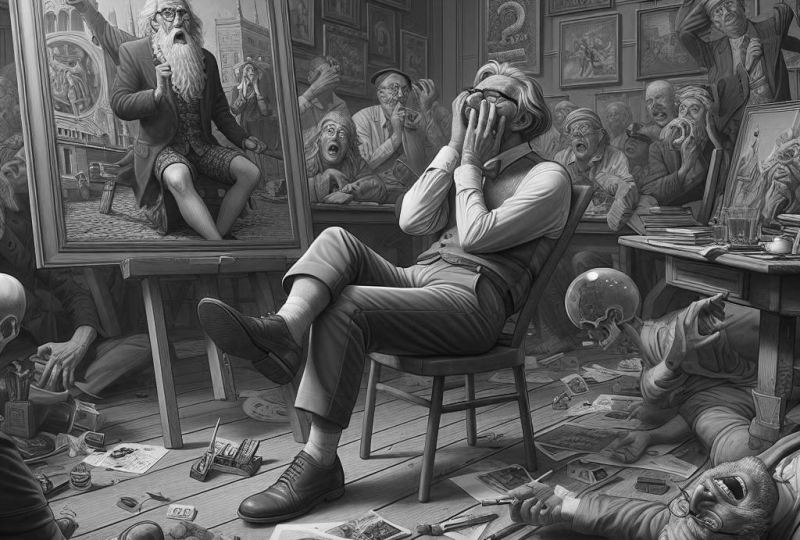
Irony in visual and stage art.
Irony in art is not just an element of humor, but a powerful means of expressing criticism, satire, or even deep meaning. It has found its place in various art forms, from visual art to theater.
- Visual art.
In visual art, irony can manifest itself through the contrast between what is being depicted and its true content. For example, the works of Banksy, which often mock political and social issues, using satirical images to emphasize the contrast between reality and illusion. - Theater.
Theatrical irony is often used as a means of emphasizing the contradictions between reality and fiction. Through the actors’ interaction with the audience, irony in theater can create a special atmosphere where the audience is immersed in the play between the played and the real. - Cinematography.
In movies, irony can manifest itself in unexpected plot twists or in the use of symbols and metaphors. For example, in the movie American Beauty, irony lies in the depiction of the ideal of the “American dream” which is actually a complete disappointment and emptiness.
Irony in art plays a key role in shaping the viewer’s critical thinking, causing them to ponder the deeper meaning of what they see or hear. It is a medium that allows artists to express their thoughts and feelings in an indirect but effective way, often mixing humor with profound social commentary.
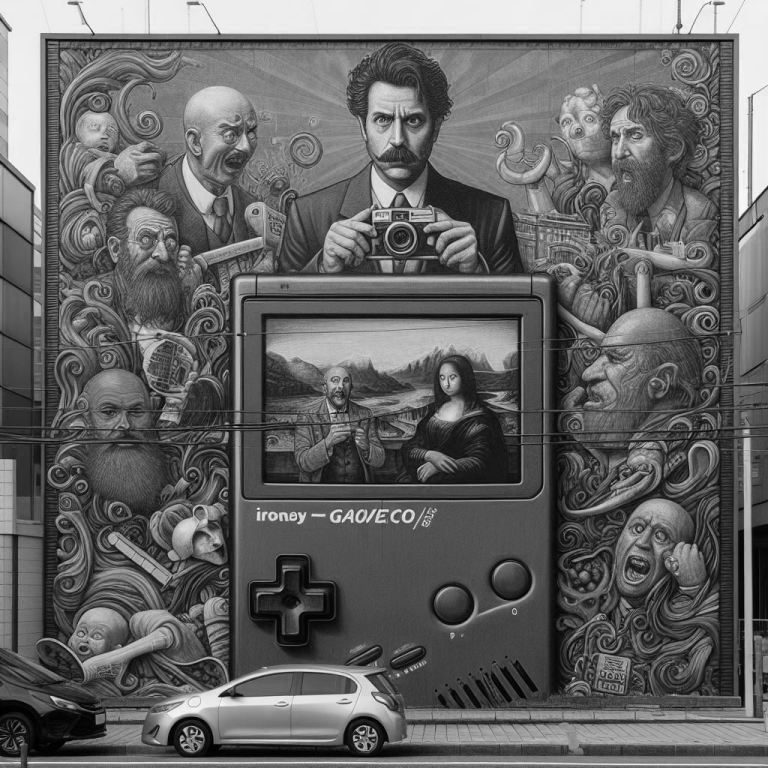
Philosophical and cultural aspect.
Irony, is an important element of cultural and philosophical discourse, and has deep roots and diverse manifestations in different cultures and philosophical currents.
- Philosophical irony.
Irony was important in ancient Greek philosophy, especially in the dialogues of Socrates (Socrates). Socratic irony took the form of asking simple questions which, however, revealed deep misunderstandings or errors in the reasoning of the interlocutor. This method was used to stimulate critical thinking and introspection, showing that irony could be a tool to reach the truth. - Cultural variations.
Different cultures have their own characteristics in the perception and use of irony. For example, British humor is often characterized by dry and subtle irony, whereas in American culture, irony may be more blunt and obvious. In Eastern cultures, irony is often manifested through innuendo and allegory, which requires a deeper understanding of the context.
Irony as a philosophical and cultural phenomenon reflects the complexity of human perception, language, and communication. It allows expressing complex ideas and emotions in an indirect way, stimulating reflection and deeper understanding of the essence of things. Irony in different cultures and philosophical traditions continues to be a source of intellectual enrichment and understanding between people.
The role of irony in human interaction.
Irony plays an important role in forming and maintaining social bonds, and is of particular importance in professional and family life.
- Social Connections.
The use of irony can both strengthen and weaken social relationships. On the one hand, ironic jokes and statements can create a sense of closeness and understanding between people who share common beliefs and values. On the other hand, irony can be used to mask criticism or discontent, which can lead to misunderstandings and conflicts, especially if the interlocutor does not understand the ironic subtext. - Workspace and family.
In professional settings, irony is often used to reduce tension or as a way of expressing criticism in a less direct way. For example, a colleague may ironically comment on the “excellent organization” of a meeting that actually had numerous flaws. In family relationships, irony can also be used as a means of expressing love and affection, but can sometimes lead to misunderstandings, especially when it is perceived as sarcasm or criticism.
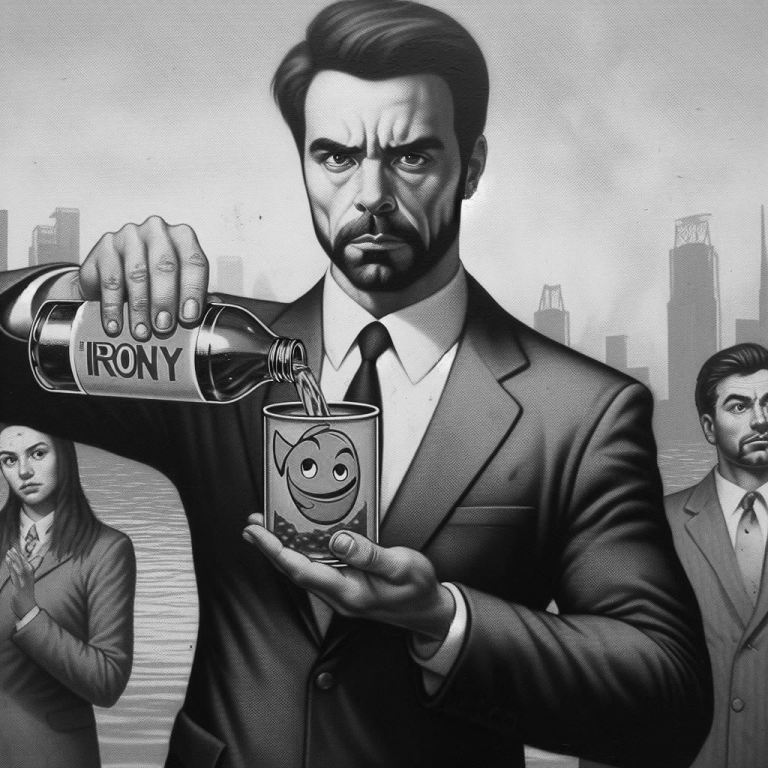
What is Post-irony — concept and definition in simple words with examples.
Post-irony is a modern cultural phenomenon that can be described as irony so deep and confusing that it becomes difficult to distinguish where seriousness ends and humor begins. It is the use of irony on a level where the traditional boundaries between irony and sincerity are blurred.
Examples of post-irony:
- Fashion Trends: Wearing clothing that was once considered “unfashionable” or “outdated” with ironic overtones. For example, using old-fashioned glasses or ethnic costumes as a fashion statement.
- Contemporary Art: Works of art that seem absurd or incomprehensible, but actually carry deep meaning. For example, an empty space in a gallery presented as an “exhibit”.
- Music: The use of old, “forgotten” genres of music in new songs, which creates an effect of nostalgia, but at the same time irony. For example, modern disco or funk songs.
- Movies and TV shows: Creating content that mimics older formats or styles, but with modern ironic undertones. For example, TV series that mimic the style of older TV shows but with an ironic modern perspective.
- Social Media: Post-irony is often found on social media, where people post images or text that appears serious at first glance but actually has a deep ironic meaning.
What is Meta-irony — concept and definition in simple words and with examples.
Meta-irony is a complex form of irony, where the act of irony itself becomes the object of ironic perception. It is when irony is used so deeply or complexly that the line between seriousness and irony becomes blurred and the irony itself becomes the object of irony.
Examples of meta-irony:
- Literary works: When a writer creates a character who constantly uses irony, and then the character itself becomes the object of irony within the work.
- Cinematography: A movie that appears to be a self-parody of its genre clichés, but takes its irony seriously, creating a double layer of irony.
- Social Media: Publications where the author ironically comments on their own use of irony in previous posts.
- Comedy shows: When comedy shows use irony to mock their own format or style.
- Art: Art works that appear to criticize their own genre or style, using irony to raise questions about the essence of art and how it is perceived.
Meta-irony is an intelligent and creative use of irony that causes the cultural consumer to reflect not only on the content of the work, but also on the very process of its creation and perception. It is a form of irony that goes beyond ordinary understanding, offering a deeper and more complex understanding of a phenomenon.
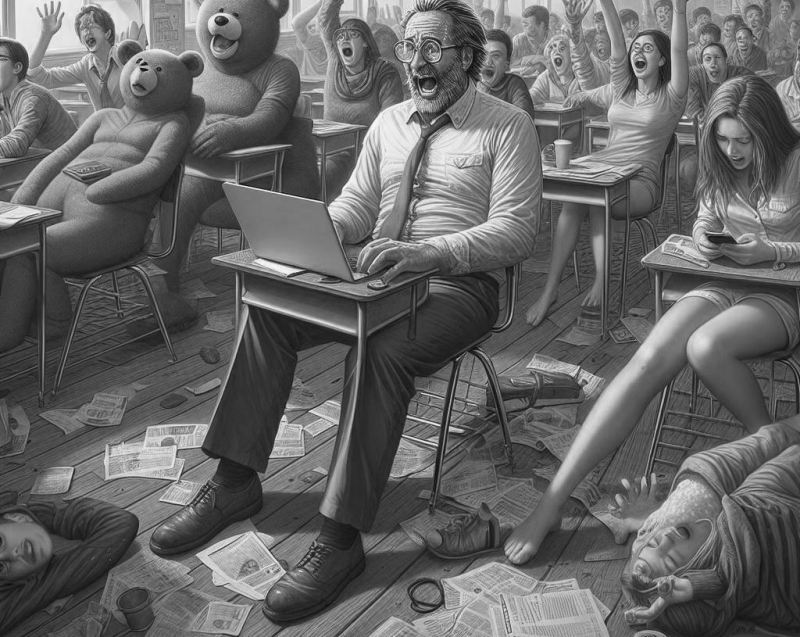
What is the difference between irony, post-irony, and meta-irony.
Irony, post-irony, and meta-irony are complex concepts that differ in their depth and context of use. Irony is usually the contrast between the literal and hidden meaning of a statement or situation. Post-irony, in turn, blurs the boundaries between irony and sincerity, and meta-irony creates another level where irony itself becomes the subject of irony.
An example of the transition from irony to post-irony and then to meta-irony.
- Irony: Let’s imagine that a person in a restaurant orders a dish that turns out to be not tasty at all. When asked by the waiter about the quality of the dish, he says, “Oh, this is the best thing I’ve ever eaten!” — ironically emphasizing his dissatisfaction with the meal.
- Post-irony: After this, let’s imagine that the person posts a picture of this dish on social media with the caption “My favorite meal at my favorite restaurant,” which creates a certain ambiguity: did he really like it, or is it ironic?
- Meta-irony: Then, the person comments on his own post by saying, “I so love being ironic on social media,” thereby questioning not only his assessment of the food, but also the very fact that he is using irony, creating a double layer of irony.
This example demonstrates how one situation can evolve from simple irony to a more complex form of meta-irony, where irony itself becomes the object of ironic perception.
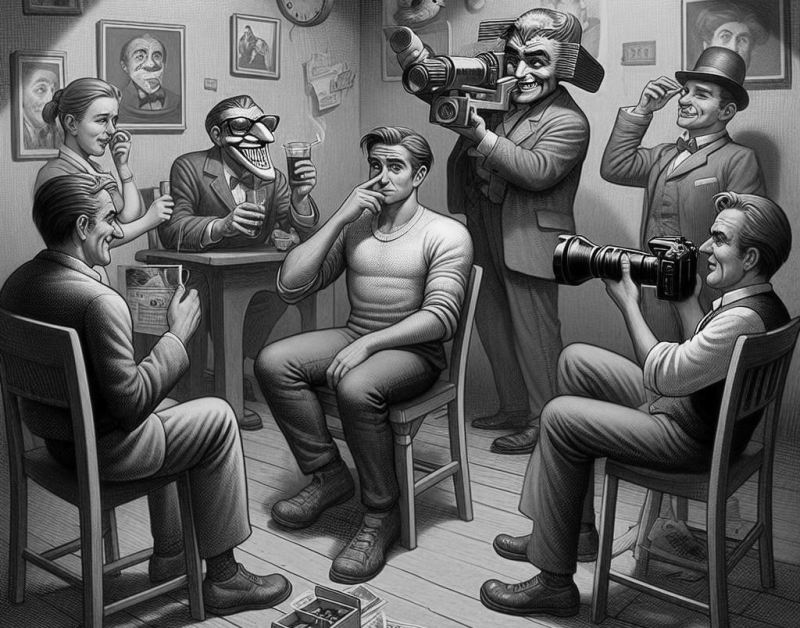
Understanding the difference between irony and sarcasm.
Irony and sarcasm are often perceived as similar, but have key differences in their use and intents. Irony often involves a humorous or light tone, where the statement is the opposite of what is expected, to emphasize a contrast or expose the absurdity of a situation. Sarcasm, on the other hand, is more harsh or critical in nature and is often used to ridicule or insult.
Example of the difference between irony and sarcasm.
Let’s imagine a situation in which Character A meets Character B, who has just arrived at the meeting wet from the rain.
- Irony: Character A says, “Well, picked a fine day for a walk, didn’t you?” The irony here is the gentle but humorous emphasis on the unexpected weather situation contrasting with the idea of a “great day for a walk”.
- Sarcasm: Character A says, “So diver, did you leave your flippers in the yard?” The sarcasm here is the use of an insulting tone and an allusion to the alleged stupidity of Character B who got caught in the rain.
Irony in this case is used to lightly mock the situation without the intent to offend, whereas sarcasm uses a harsher tone and aims to ridicule or even insult the other person. Understanding this distinction helps in everyday communication and interpersonal relationships.
Conclusion.
In this article, we have examined the complexity of irony, its various forms, and its impact on human communication and culture. From classical irony, which is characterized by the opposition between literal and implicit content, to post-irony, which blurs the boundaries between irony and sincerity, and on to meta-irony, where irony itself becomes the subject of irony, these concepts play a significant role in contemporary cultural and social discourse. Understanding these distinctions helps us better appreciate the subtleties of interpersonal relationships, art, literature, and even everyday communication. Irony, in all its forms, remains a key tool for expressing complex ideas and emotions in an indirect but influential way.

FAQ (Frequently Asked Questions):
Irony is when a statement or situation has the opposite meaning of what is literally said or happening.
Irony is often light, humorous in nature, while sarcasm is harsher and often intended to criticize or insult.
Post-irony is the use of irony on such a level that it becomes difficult to distinguish where the seriousness ends and the joke begins.
Post-irony can be found in fashion, art, music, where old styles or ideas are used in a new, often unexpected context.
Meta-irony is when irony itself becomes the object of ironic perception, creating a double layer of irony.
In art, meta-irony can manifest itself through self-reflection, when a work comments on its own form or content.
Yes, irony can be used to create humor, reduce tension in communication, or highlight the absurdity of situations.
Irony can strengthen relationships between people who share a common sense of humor, but it can also lead to misunderstandings if misinterpreted.
In writing, irony can be recognized by context, unexpected content, or the use of specific symbols such as emoji.
Yes, the perception of irony can vary significantly across cultures, depending on linguistic, social, and cultural characteristics.

